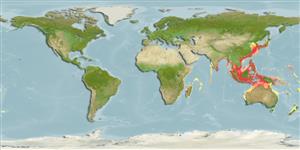Common names from other countries
Environment: milieu / climate zone / depth range / distribution range
Ecologia
; intervalo de profundidade 2 - 219 m (Ref. 409). Tropical (Ref. 8)
Indo-West Pacific: from Japan to Indonesia and Malaya.
Length at first maturity / Tamanho / Peso / Idade
Maturity: Lm ? range ? - ? cm Max length : 10.8 cm TL macho/indeterminado; (Ref. 8)
Inhabits sand, mud or sandy-mud bottoms from depths of 2-219 m, usually at less than 90 m (Ref. 409).
Life cycle and mating behavior
Maturidade | Reprodução | Desova | Ovos | Fecundidade | Larvas
Members of the order Decapoda are mostly gonochoric. Mating behavior: Precopulatory courtship ritual is common (through olfactory and tactile cues); usually indirect sperm transfer.
Holthuis, L.B. 1980. (Ref. 8)
Categoria na Lista Vermelha da IUCN (Ref. 130435)
Categoria CITES (Ref. 108899)
Not Evaluated
Not Evaluated
Utilização humana
Pescarias: espécies comerciais
| FishSource |
Ferramentas
Fontes da internet
Estimates based on models
Preferred temperature
(Ref.
115969): 16.6 - 28.5, mean 27.1 (based on 1024 cells).
Resiliência
Elevada, tempo mínimo de duplicação da população menor que 15 meses (K=1.14-1.94).
Vulnerabilidade
Low vulnerability (10 of 100).
